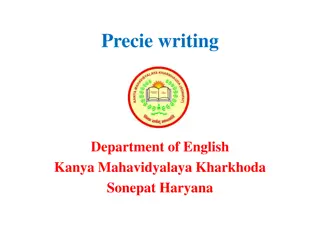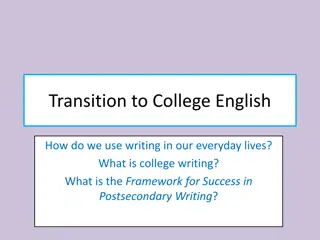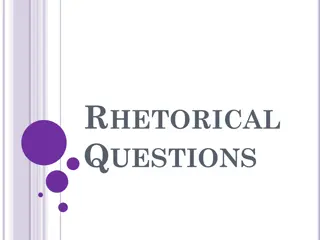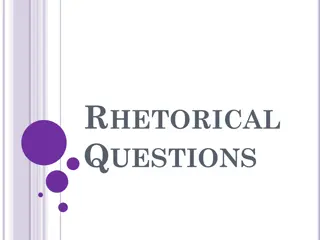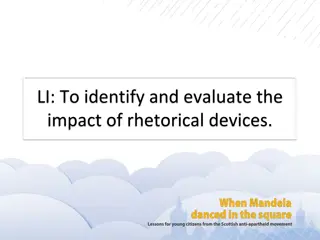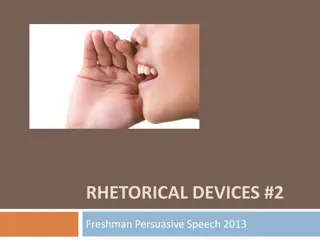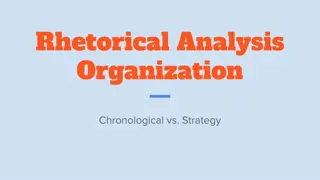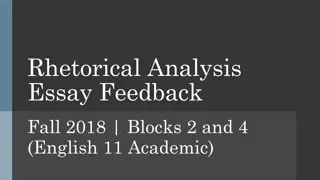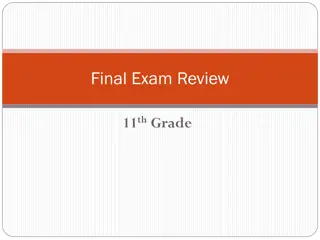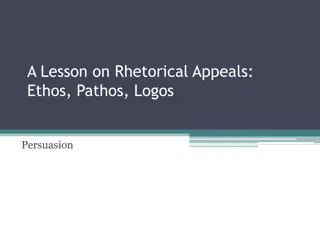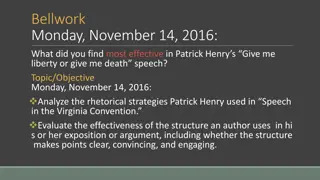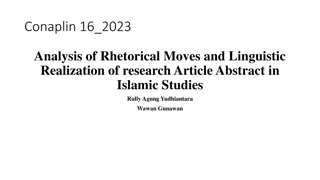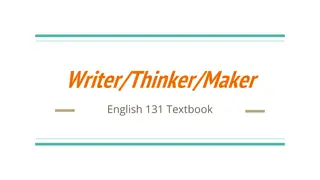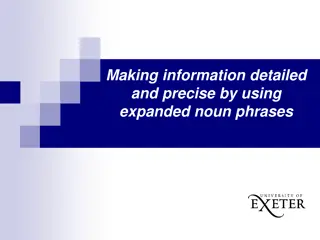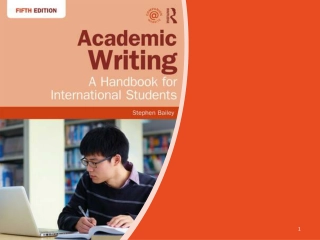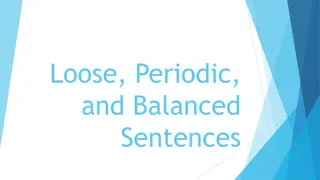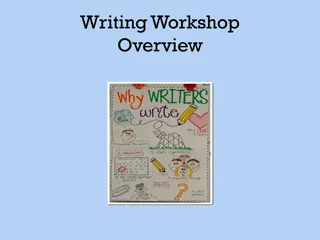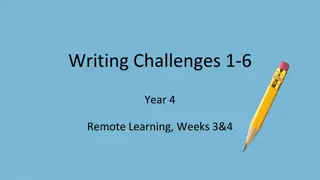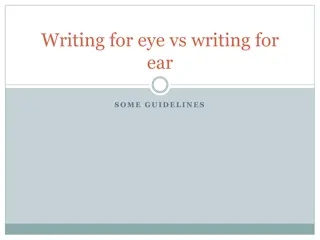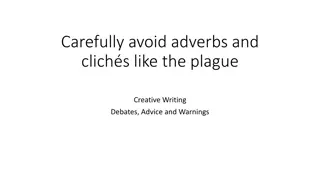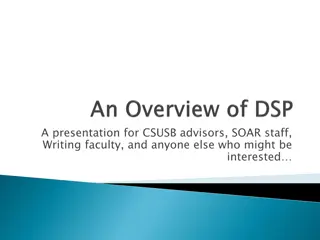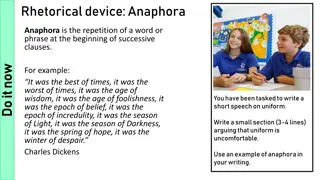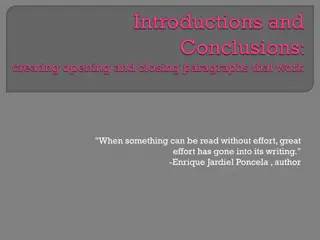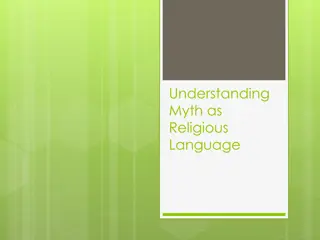Understanding Rhetorical Précis Writing
A rhetorical précis is a structured four-sentence paragraph that addresses the rhetorical situation of a discourse, capturing essential elements such as the author's name, title, publication date, major assertion, purpose, and audience relationship. The first sentence introduces the author and thesis, the second explains how the thesis is developed, the third states the author's purpose, and the fourth contextualizes the relationship between the author and audience.
Download Presentation

Please find below an Image/Link to download the presentation.
The content on the website is provided AS IS for your information and personal use only. It may not be sold, licensed, or shared on other websites without obtaining consent from the author. Download presentation by click this link. If you encounter any issues during the download, it is possible that the publisher has removed the file from their server.
E N D
Presentation Transcript
WHAT IS A RHETORICAL PRCIS? A rhetorical pr cis is a highly structured four A rhetorical pr cis is a highly structured four- -sentence paragraph that acknowledges the rhetorical situation in which any discourse that acknowledges the rhetorical situation in which any discourse occurs. The pr cis records the essential rhetorical elements involved occurs. The pr cis records the essential rhetorical elements involved in writing and in reading discourse: the name of the speaker/writer, in writing and in reading discourse: the name of the speaker/writer, the context of the delivery, the major assertion, the mode of the context of the delivery, the major assertion, the mode of development and/or support, the stated and/or apparent purpose, development and/or support, the stated and/or apparent purpose, and the relationship established between the speaker/writer and and the relationship established between the speaker/writer and the audience. the audience. sentence paragraph Woodworth, Margaret K. "The Rhetorical Woodworth, Margaret K. "The Rhetorical Precis 2011. 2011. Precis." ." Rhetoric Review Rhetoric Review 7.1 (1988): 156 7.1 (1988): 156- -64. 64. ERIC ERIC. EBSCO. Web. 27 Oct. . EBSCO. Web. 27 Oct.
SENTENCE 1 The first sentence should include: The first sentence should include: the author s name(s) the author s name(s) the title of the work the title of the work the date of publication in parentheses the date of publication in parentheses a rhetorically accurate verb (such as asserts, argues, suggests, implies, claims) a rhetorically accurate verb (such as asserts, argues, suggests, implies, claims) a that a that- -clause containing the major assertion (thesis statement) of the work clause containing the major assertion (thesis statement) of the work Ex: Patrick Sullivan in An Open Letter to High School Students about Reading (2016) asserts that one of the most important things students can do to prepare for college is to ready deeply and for pleasure.
SENTENCE 2 The second sentence should explain : The second sentence should explain : how the author develops and/or supports the thesis. how the author develops and/or supports the thesis. should discuss methodology should discuss methodology how the article works; that is, how how the article works; that is, how the author accomplishes his/her task. the author accomplishes his/her task. should also support the strong verb used in SENTENCE 1. should also support the strong verb used in SENTENCE 1. should cite where to locate the specific points addressed. should cite where to locate the specific points addressed. Ex: Ex: Sullivan supports this assertion by citing academic studies, scientific research, and expert testimony while exploring what it means to read and to learn deeply.
SENTENCE 3 The third sentence should: The third sentence should: State the author s apparent purpose, followed by an State the author s apparent purpose, followed by an in order to or in order for phrase in order to or in order for phrase Ex: Ex: The writer concludes that students must read frequently and with engagement in order to be prepared for college and beyond.
SENTENCE 4 The fourth sentence should: The fourth sentence should: Describe the intended audience and/or the relationship the Describe the intended audience and/or the relationship the author establishes with the audience. author establishes with the audience. Identify the audience and/or the purpose of the essay. Identify the audience and/or the purpose of the essay. Ex: Ex: The writer establishes a conversational tone to convince his audience of high school students that they must find a way to enjoy reading and to make it a part of their everyday lives.
GIVE THE MLA CITATION Head each pr cis with the MLA Head each pr cis with the MLA- -style citation for the article or book: style citation for the article or book: Sullivan, Patrick. An Open Letter to High School Students about Reading. American Association of University Professors, May- June 2016, www.aaup.org/article/open-letter-high-school- students-about-reading#.WgSEcmhSzIU. Accessed 16 November 2017.
SAMPLE RHETORICAL PRCIS Sulllivan, Patrick. An Open Letter to High School Students about Reading. American Association of University Professors, May-June 2016, www.aaup.org/article/open-letter-high-school- students-about-reading#.WgSEcmhSzIU. Accessed 16 November 2017. Patrick Sullivan in An Open Letter to High School Students about Reading (2016) asserts that one of the most important things students can do to prepare for college is to ready deeply and for pleasure. Sullivan supports this assertion by citing academic studies, scientific research, and expert testimony while exploring what it means to read and to learn deeply. The writer concludes that students must read frequently and with engagement in order to be prepared for college and beyond. The writer establishes a conversational tone to convince his audience of high school students that they must find a way to enjoy reading and to make it a part of their everyday lives.
GRADING Assessment for Rhetorical Pr cis Possible Points 5 Earned Points Adheres to the form of the rhetorical pr cis (MLA citation, formatting and sentence formulas) Content thoughtfully and accurately represents the original text; represents a synthesis of the original ideas (copying and pasting any part of the original text or abstract will result in an automatic zero). 15 Sentence structure adheres to standard conventions of grammar, usage and mechanics. 5 TotalPoints: 25
WHY USE THE RHETORICAL PRCIS? The processes involved in pr cis writing help students develop as The processes involved in pr cis writing help students develop as language users. The reading and rereading accelerate acquisition of the language users. The reading and rereading accelerate acquisition of the written language system (see Falk, Kroll, written language system (see Falk, Kroll, Krashen Krashen); the extensive writing ); the extensive writing and rewriting accelerate learning by providing guided practice in a variety and rewriting accelerate learning by providing guided practice in a variety of writing tasks such as thesis formation, sentence structuring (e.g., of writing tasks such as thesis formation, sentence structuring (e.g., subordination and parallel construction), punctuation, word choice, and even subordination and parallel construction), punctuation, word choice, and even techniques of documentation. techniques of documentation.


